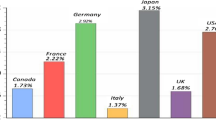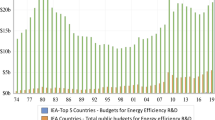Abstract
This study, based on the N-shaped cubic model of the environmental Kuznets curve, analyzes the evolution of per capita greenhouse gas emissions (GHGpc) using not just economic growth but also public budgets dedicated to energy-oriented research development and demonstration (RD&D) and energy intensity. The empirical evidence, obtained from an econometric model of fixed effects for 28 OECD countries during 1994–2010, suggests that energy innovations help reduce GHGpc levels and mitigate the negative impact of energy intensity on environmental quality. When countries develop active energy RD&D policies, they can reduce both the rates of energy intensity and the level of GHGpc emissions. This paper incorporates a moderating variable to the econometric model that emphasizes the effect that GDP has on energy intensity. It also adds a variable that reflects the difference between countries that have made a greater economic effort in energy RD&D, which in turn corrects the GHG emissions resulting from the energy intensity of each country.






Similar content being viewed by others
Notes
Empirical evidence suggests complementarity between measures for pollution reduction and economic growth, which would have a bearing on the potential for lower income requirements to achieve environmental decontamination (Cantos and Balsalobre 2011).
Initially, economic development is characterized by the application of distorting policies, such as subsidies for energy consumption, and by market failures, such as incorrect definitions of property rights or a lack of payment for environmental externalities (De Bruyn and Heintz 1999; Panayotou 1993). The second phase leads to the disappearance of distortions and a correction of market failures. Subsequent stages then involve the implementation of strict environmental policies and greater environmental awareness. Thus, institutional changes, in parallel with economic development, also can reveal the pattern described by the EKC (Jones and Manuelli 1995). Selden and Song (1994) acknowledge that well-administered corrective measures allow for lower income levels before correction occurs.
When the EKC takes an N-shaped form, environmental pollution increases at a low level of income, then reaches a turning point and begins to decline, after which it increases again. The authors cite evidence of the N shape but also interpret the last stretch of the ascending income curve as too high for most regions. Thus they largely ignore the cubic shape of the function and focus instead on the inverted U (quadratic form).
Grossman and Krueger (1995) allude to the possibility of an N pattern, as a statistical result of stabilization in the level of GHG emissions or as a recovery effect, after the initial impact of the shock. Moomaw and Unruh (1997) suggest that developed countries would have experienced a structural transition toward lower CHG emissions in the wake of the 1973 oil crisis, such that the cubic shape would result more from adjusting the polynomial curve, reflecting an underlying structural relationship. Panayotou (1997) argues that no special significance should be accorded to the possibility of returning to a new tier of increasing pollution, because such a rise often occurs outside the range of data or at the end, where there are relatively few observations.
Opschoor and Vos (1989) propose that with depletions of improvements in technological efficiency or costly applications, further growth in income levels results in greater environmental degradation.
The 28 OECD countries are Australia, Austria, Belgium, Canada, Czech Republic, Denmark, Finland, France, Germany, Greece, Hungary, Ireland, Italy, Japan, Korea, Luxembourg, the Netherlands, New Zealand, Norway, Poland, Portugal, Slovak Republic, Spain, Sweden, Switzerland, Turkey, the UK, and the USA.
In Fisher’s empirical methodology of distributed lags, any cause can produce an effect only after some time lag, and this effect is not felt all at once but rather is distributed over multiple points in time.
The dummy variable (DRANKING it ) indicates 15 countries that spent more of their public budgets during 2008–2010 on energy RD&D as follows: Australia, Austria, Canada, Denmark, Finland, France, Hungary, Ireland, Japan, Korea, the Netherlands, Norway, Sweden, Switzerland, and the USA.
The estimation of the turning points for the cubic model used the following formulation (Diao et al. 2009):
$$ Xj=\frac{-{\beta}_2\pm \sqrt{\beta_2^2-3{\beta}_1{\beta}_3}}{3{\beta}_3},\forall j=1,2 $$where X 1 represents the first breaking point and X 2 is the second. After this point, economic growth again produces an increase in the rate of environmental destruction.
References
Adjaye J (2000) The relationship between energy consumption, energy prices and economic growth: time series evidence from Asian developing countries. Energy Econ 22:615–625
Aguinis H (2004) Regression analysis for categorical moderators. Guilford Press, New York
Alcantara V, Duro JA (2004) Inequality of energy intensities across OECD countries: a note. Energy Pol 32:1257–1260
Andreoni J, Levinson A (1998) The simple analytics of the environmental Kuznets curve. NBER Working Papers 6739
Arrow K, Bolín B, Constanza R, Dasgupta P, Folke C, Holling C, Jansson B, Levin S, Mäler K, Perrings C, Pimentel D (1995) Economic growth carrying capacity, and the environmental. Science 268:520–521
Beckerman W (1992) Economic growth and the environment: whose growth? Whose environment? World Dev 20:481–496
Bergh JC, Van Den JM, Nijkamp P (1994) Dynamic macro modeling and materials balance: economic environmental integration for sustainable development. Econ Model 11:283–307
Bovenberg LA, Smulders S (1995) Environmental quality and pollution-augmenting technological change in a two-sector endogenous growth model. J Public Econ 57:369–391
Cantos JM, Balsalobre D (2011) Las energías renovables en la Curva de Kuznets Ambiental: Una aplicación para España. Estud Econ Apl 29-2:32
Cantos JM, Balsalobre D (2013) Incidencia del gasto público en I + D + i energético sobre la corrección medioambiental en España. Estud Econ Apl 31(1):93–126
Chaudhuri S, Pfaff A (1998) Does indoor air quality fall or rise as household incomes increase?’, SIPA Working Paper 1, Columbia University
De Bruyn SM, Heintz RJ (1999) In: Van Den Bergh JCJM (ed) Handbook of environmental and resource economics. Edward Elgar, Cheltenham and Northampton
Diao X, Zeng S, Tam C, Tam V (2009) EKC analysis for studying economic growth and environmental quality: a case study in China. J Clean Prod 17(5):541–548
Dinda S (2004) Environmental Kuznets Curve: a survey. Ecol Econ 49:431–455
Dowlatabadi H, Oravetz MA (2005) US long-term energy intensity: backcast and projection. Energy Pol 34:3245–3256
Fisher I (1937) Bull Inst Int Stat 29:323–328
Focacci A (2003) Energy Pol 31:333–352
Gradus R, Smulders S (1993) J Econ 58:25–51
Grossman G, Krueger E (1991) Environmental impacts of a North American Free Trade Agreement. NBER Working Paper, 3914
Grossman G, Krueger E (1995) Q J Econ 110(2):353–377
Grübler A (1998) Technology and global change. Cambridge University Press, Cambridge
Halkos G (2011) J Appl Econ Sci 2(16):148–159
Hettige H, Mani M, Wheeler D (2000) J Dev Econ 62:445–476
Holtz-Eakin D, Selden T (1995) J Public Econ 57(1):85–101
Jones L, Manuelli R (1995) A positive model of growth and pollution controls. NBER Working Papers 5205, National Bureau of Economic Research, Inc
Kaika D, Zervas E (2013) Energy Pol 62:1392–1402
Kander A (2005) Ecol Econ 55:119–130
Kenny D (1979) Correlation and causality. Wiley, New York
Kuznets S (1955) Am Econ Rev 45:1–28
Lantz V, Feng Q (2006) Ecol Econ 57:229–238
Lindmark M (2002) Ecol Econ 42:333–347
Luzzati T, Orsini M (2009) Energy 34:291–300
Meadows DL, Meadows DH, Randers J, Behrens W (1972) The limits to growth: a report for the Club of Rome’s Project on the Predicament of Ma Universe Books, New York
Mendiluce M, Linares P (2007) Análisis de la evolución de la intensidad energética en España. Econ Energy
Moomaw W, Unruh G (1997) Environ Dev Econ 2:451–463
Munasinghe M (1999) Ecol Econ 29(1):89–109
Neumayer E (1998) J Environ Law Policy 2(98):161–176
OECD (2013) IEA Energy Technology RD&D Statistics, http://www.oecd.org/statistics/
Opschoor JB, Vos HB (1989) Economic instruments for environmental protection. OECD, Paris
Panayotou T (1993) Empirical test and policy analysis of environmental degradation at different stages of economic development. Working Paper 238, Technology and Environment Programme, International Labour Office, Geneva, 1993
Panayotou T (1997) Environ Dev Econ 2:465–484
Richmond AK, Kaufmann RK (2006) Ecol Econ 56:176–189
Selden T, Song D (1994) J Environ Econ Manag 27(2):147–162
Shafik N (1994) Economic development and environmental quality: an econometric analysis. Oxford Economic Papers, New Series 46, Special Issue on environmental economics, October 1994, 757–773
Shafik N, Bandyopadhyay S (1992) Economic growth and environmental quality: time-series and cross-country evidence. World Bank Working Papers 904, 1–6. Washington DC
Stagl S (1999) Delinking economic growth from environmental degradation? A literature survey on the Environmental Kuznets Curve Hypothesis. Working Paper Series of the Research Focus Growth and Employment in Europe: Sustainability and Competitiveness 6, Wartschaftsuniversitat Wien
Stokey L (1998) Int Econ Rev 39:1–31
Sun JW (2002) Energy Pol 30:631–635
Tol RSJ, Pacala SW, Socolow RH (2009) J Policy Model 31:425–445
Torras M, Boyce J (1998) Ecol Econ 25:147–160
Turner K, Hanley N (2011) Energy Econ 33:722–741
Unruh GC, Moomaw WR (1998) Ecol Econ 25:221–229
Verdier T (1993) Environmental pollution and endogenous growth: a comparison between emission taxes and technological standards. Fondazione Eni Enrico Mattei Discussion Paper 57(93)
Vliamos S, Tzeremes N (2011) J Knowl Econ. doi:10.1007/s13132-011-0043
Wang P, Bohara AK, Berrens R, Gawande K (1998) Appl Econ Lett 5:761–763
World Commission For Environment And Development (WCED) (1987) Our common future. Oxford University Press, Oxford
Wu AD, Zumbo BD (2008) Soc Indic Res 87:367–392
Author information
Authors and Affiliations
Corresponding author
Additional information
Responsible editor: Philippe Garrigues
Rights and permissions
About this article
Cite this article
Balsalobre, D., Álvarez, A. & Cantos, J.M. Public budgets for energy RD&D and the effects on energy intensity and pollution levels. Environ Sci Pollut Res 22, 4881–4892 (2015). https://doi.org/10.1007/s11356-014-3121-3
Received:
Accepted:
Published:
Issue Date:
DOI: https://doi.org/10.1007/s11356-014-3121-3




